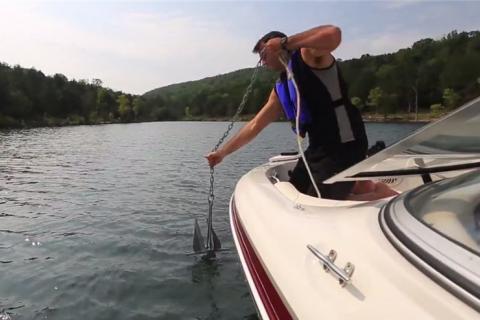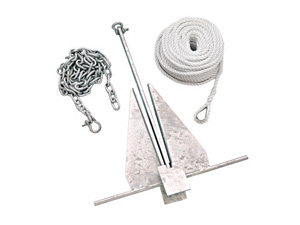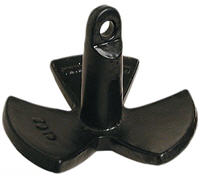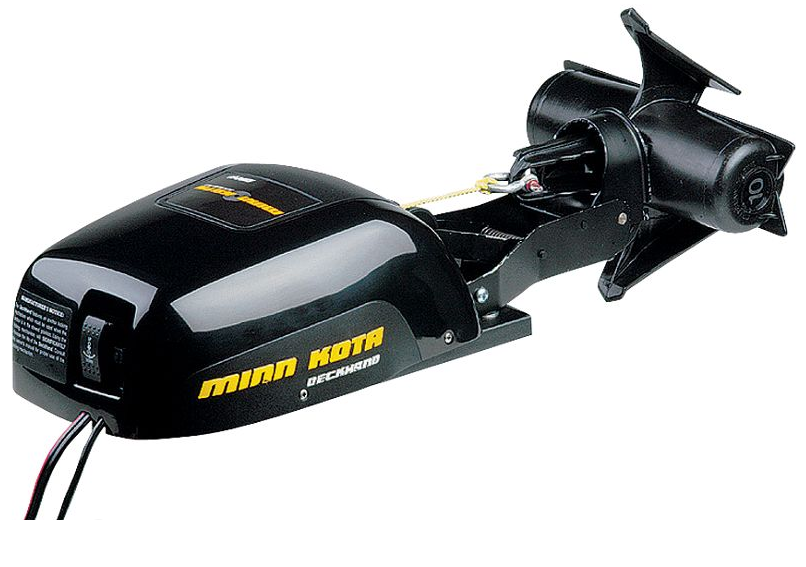
From the basic "cement-in-a-bucket" to the tried-and-true fluke or grapnel, boat anchors come in a wide variety of shapes and styles. No matter what size boat you skim across your favorite lake in, having an anchor on board assures safe boating, while also permitting the angler to have a controlled and drift-free fishing excursion.
 Choosing the appropriate anchor can be a frustrating task if you don't know the merits of each particular design. Follow this handy guide and prepare to become a boat anchor guru.
Choosing the appropriate anchor can be a frustrating task if you don't know the merits of each particular design. Follow this handy guide and prepare to become a boat anchor guru.
TIP: Click for more chart information about boat anchor types.
What Type of Boat Anchor Should I Buy?
Although this question may seem basic, there are many variables that come into play when purchasing your first anchor. Environmental conditions (such as weather and lake structure), the size of your craft and the weight of the anchor itself are all significant parts of the puzzle. Perhaps it's best to look first at how an anchor actually works.
Anchors "attach" to the bottom structure of a body of water in order to hold a boat securely. This is done in one of two ways. Firstly, the anchor can penetrate the bottom surface, creating a suction through the penetration and the weight of the material above the anchor itself, in turn creating resistance. Secondly, when dealing with hard, rocky bottoms, the anchor actually snags in order to create hold.
Out of the many roles that anchors serve, the most prevalent are securing the boat while fishing, keeping boats out of the surf or rocks or allowing the occupants to enjoy a relaxing meal on board without drifting away. (For larger craft, anchors are also necessary for spending the night while out on the water.)
Tip Read: Pros and Cons of Dropping the Anchor When Fishing for River Bass
Boat Safety: How to Anchor Your Boat
There's more to anchoring your boat than just dropping it in the water. Watch this boat anchor safety video demonstrate the proper techniques to anchoring. Watch the full video by taking an online boating safety course at Boat-ed.com.
What to Look for in an Anchor
As you will realize after reading this guide, not all anchors are created equal. There are, however, common attributes that you should look for when making your choice.
- Holds well in all types of bottom: weed, rock, sand, mud.
- Can be set and re-set quickly and easily under all conditions.
- Strong craftsmanship.
- Good holding power.
- Can be released easily and effortlessly from the bottom.
- Can be stored easily on deck — compact
Boat Anchor Styles

Anchor
The following represents a list of the most common anchor designs currently on the market
River Anchor:
The river anchor is designed specifically for river currents and heavy drift conditions. The grappling action of the three individual blades provides secure holding power, while the flow-through holes provides easy pull up.
Grapnel Anchor:

Grapnel Anchor Kit
Most grapnel anchors like the Bass Pro Shops Grapnel Anchor are made with four arms that easy fold up, providing a compact and easily stored apparatus. This style of anchor is ideal for small boats and dinghies as there are no open flukes to puncture the sensitive fabric of the craft.
Mushroom Anchor:

Mushroom Anchor
The mushroom anchor offers a wide area cap that offers effective holding power in mud and weeds. The drain holes in the base allow for easy retrieval, allowing water and mud to quickly be displaced.
Navy Anchor:

Navy Anchor
The navy anchor such as the Bass Pro Shops Navy Anchor is the traditional style of anchor. The stock is made to fold flat against the shank for easy storage, making these ideal for smaller craft. Navy anchors work well in rocky bottoms, and will also penetrate easily through weeds.
Fluke Anchor:

Fluke Anchors
The fluke anchor, or Danforth, has two "flukes" or appendages that are used to hold on the bottom. The stock-in-head design is what makes this anchor work, not the weight, and it provides extremely high penetration. Flukes work best in sand or loose gravel, literally burying themselves out of sight when lowered. One drawback is rocks or boulders — they can become wedged in so tight that the only option is cutting them free.
Electric Anchors:
 |
| The Minn Kota® DeckHand Anchor Winch lets you to automatically raise your anchor with the push of a button. |
This type of anchor is a hands-free style with a electric anchor winch attached to the bow of the boat. With the simple flick of a switch, the anchor can be raised or lowered, allowing the boater more time for other concerns. The one drawback this system has is that the anchor itself is usually in the style of the mushroom — great for muddy or sandy conditions, but a poor choice for rocky areas. However, for people with disabilities or back problems, this anchor system certainly has its merits.
What Size Anchor Do I Need?
Deciding on a certain size of anchor can be a bit of a guessing game. Since conditions are always changing, there is no "right" size for the job at hand. One misconception people make when shopping for an anchor is the heavier the better. This is just not true. Physical size, rather than weight, is actually a better indicator of the anchors holding ability. (Some anchors that only weigh 5lbs. can hold in excess of 1,000 pounds!)
When it comes to choosing an anchor, bigger is almost always better. Bigger anchors have more strength to resist breaking, occupy more of a surface area to resist pullout and will have more weight to penetrate deeper. Go with the biggest anchor you can get by with for the size of your watercraft; the last thing you need when rough weather arrives is an inadequate anchor that doesn't do the job.
Cost & Construction
It goes without saying that buying a cheap or inferior product will usually only turn to heartache. When dealing with something that could possibly save your life, please don't scrimp in order to save a few bucks. Try to buy the best anchor that you can afford, making sure to be on the lookout for spotty galvanizing, poor welds, and other noticeable inconsistencies in the metal. Always remember — you often get what you pay for.
Boat Cleats
Many people buy anchors, failing to realize that they need something to attach the rope to on their boat. This is where cleats enter the picture. Deck cleats are of a simple design, meant for anchor ropes to be wrapped around for a secure hold. Look for strong, large cleats that will withstand the punishment and pull that inclement weather can throw at them.
Attaching a Anchor to a Boat
Nylon anchor rope is the most common way of attaching an anchor to a boat. These ropes are strong, flexible and have a very high breaking strength.
| Rope Diameter | Breaking Strength |
| 3/8" | 4,400 lbs |
| 7/16" | 5,900 lbs |
| 1/2" | 7,500 lbs |
| 5/8" | 12,200 lbs |
| 3/4" | 16,700 lbs |
| 1" | 29,400 lbs |
Choosing the appropriate size of nylon rope can be made easier depending on the size of boat you are using.
| Boat Length (under) | 16-foot | 20-foot | 25-foot |
30-foot |
| Rope Diameter | 3/8" | 3/8" | 1/2" | 1/2" |
Although they may look quite similar in appearance, they really do have specialized attributes that are designed for different purposes.
| Shop all boat anchors at BassPro.com |
- 270698 views

